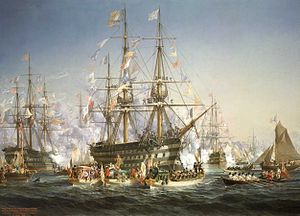French ship Bretagne (1855)

The Bretagne, painting by Jules Achille Noël, National Maritime Museum, London.
|
|
| History | |
|---|---|
|
|
|
| Builder: | Brest arsenal |
| Laid down: | January 1853 |
| Launched: | 17 February 1855 |
| Commissioned: | 1855 |
| In service: | 1855 |
| Struck: | 1879 |
| Fate: | Scrapped 1880 |
| General characteristics | |
| Displacement: | 5289 tonnes, 6875 tonnes full charge |
| Length: | 81 m (266 ft) (at the water line) |
| Beam: | 18.08 m (59.3 ft) |
| Draught: | 8.56 m (28.1 ft) |
| Propulsion: | Indret steam engine, 8 boilers, 4800 shp, 1 propeller |
| Speed: | 12.6 knots (23.3 km/h; 14.5 mph) |
| Boats & landing craft carried: |
1 13 metre boat, one 11.5 metre boat, 4 10.5 metre boats, 1 8 metre boat, 4 whaleboat, 2 dinghies |
| Capacity: | up to 1800 passengers |
| Complement: | 1170 men |
| Armament: |
|
| Armour: | timber |
The Bretagne was a fast 130-gun three-decker of the French Navy, designed by engineer Jules Marielle. Built as a new capital ship meant to improve upon the very successful of the Océan class while avoiding the weaknesses found on Valmy, she retained most of the Océan design but ended up incorporating the philosophy of "fast ship of the line" pioneered by Napoléon, with a rounded stern and a two-cylinder, 8-boiler steam engine allowing her a speed of 13.5 knots. The propeller could be retracted to streamline the hull when sailing under sail only.
She took part in the Crimean War in 1854 and 1855, and was decommissioned in 1866. She was then used as barracks and as a schoolship for boys and sailors in Brest. Struck from the Navy lists in 1879, she was broken up the following year.
Bretagne was the offspring of an attempt to improve upon the Océan class by increasing the beam from 16.24 to 16.64 metres.
The 1849 budget initially allowed for construction of a new three-decker capital ship named Terrible in Brest, but the ship was cancelled in 1848 to slim down expenses. The 1850 budget then scheduled two ships, named Bretagne and Desaix (in honour of Louis Desaix), to be built in Brest and Cherbourg respectively; the order was placed on 15 March 1851. The mediocre performances of Valmy during her trials led to the Navy shedding the capital ship design of the Commission de Paris and start back from Sané's Océan design, with only incremental modifications. In late 1851, engineers De Gasté, responsible for Bretagne, and Forquenot, for Desaix, decided on a reduction of the tumblehome by 20 centimetres and on a slight increase of the beam — alterations thought safe, as the two last ships of the Océan design, Ville de Paris and Louis-XIV, had had their tumblehome reduced by 23 centimetres with no ill effect. An initial suggestion to fit the ships with 160 shp steam engines allowing for a speed of 4,5 knots was declined as to minimise departures from Sané's design.
...
Wikipedia
